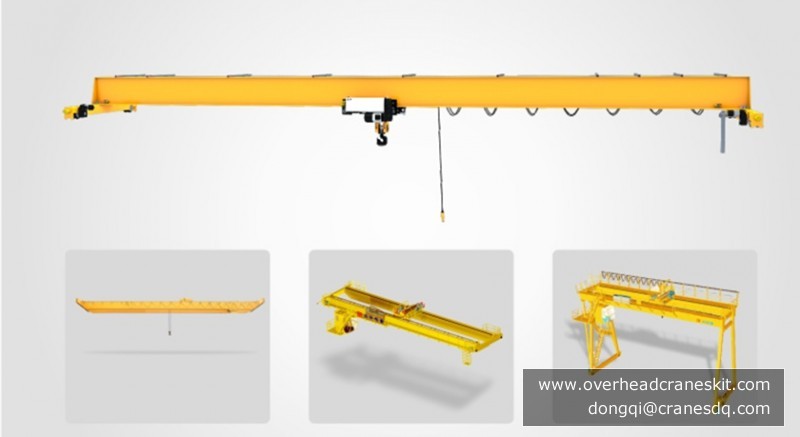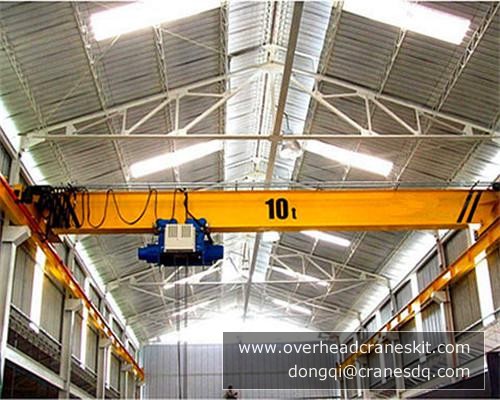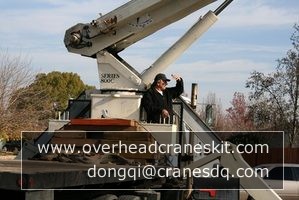As a particular type of overhead crane, the explosion-proof overhead crane we produced is qualified for various dangerous and hostile working conditions, which contains workshop of metallurgical mills, petrochemical plant, natural gas fired power plant and paint shop. All our rich experience and advanced technology are built into every overhead crane equipment or component. We produce each lifting device all on the basis of international standard and regulations.
Overhead Crane Blog
50 ton overhead crane is a type of bridge crane. Because of high working duty and big working capacity, 50 ton bridge crane is widely used in industrial and mining enterprises, steel industry, chemical industry, railway traffic and port or pier. Overhead crane 50 ton is also called heavy duty overhead crane, can be used in several complex and poor environment. 50 ton bridge crane plays a very important role in the warehouse or factory, which can increase productivity effectively and maximum save spending.
As a type of bridge crane, overhead traveling crane is designed to lift, move or transport materials up to 120 tons. Because of the great spans and big lifting capacity, an overhead traveling crane is the ideal solution for particularly demanding tasks. According to the different ways of manipulation, the traveling overhead cranes can be divided into manual overhead traveling crane and electric overhead traveling crane. And an electric overhead traveling is made up of five parts. The bridge girders, end carriages, hoisting trolley also called crab, long travel machinery and cabin. Due to best meet the requirements of high safety and productivity, the traveling overhead crane is widely used in factory, warehouse, workshop and other place.
10 ton overhead crane is a kind of bridge crane, which can meet the need of productivity and safety perfectly in factory, warehouse, and port or stuff yard. Because high working duty and best stability, overhead crane 10 ton provide so much convenient for moving, lifting and transmitting goods or other materials.
As a main type of overhead crane, single girder overhead crane is ideal solution for lift, move or transport materials. Commonly, single girder bridge crane is regarded as a kind of light duty lifting equipment match with CD1, MD1 type electric hoist. In order to best meet the demands of productivity and safety, the single beam bridge crane is widely used in workshop, warehouse, and yard.
Dongqi 2 Ton Bridge Crane Leaves Your Demands Now2 ton bridge crane is a type of overhead crane, can be classified into portable or mobile bridge crane. As a light weight bridge crane, 2 ton bridge crane is widely used in factory, coal mine, harbor, warehouse and workshop to lift, move or load materials. A 2 ton bridge crane can best meet the requirements of high-safety and productivity in factories.
Under hung bridge crane, also called under slung bridge crane or under running bridge crane, which are designed for flexibility and functionality. Because the under hung system is usually lighter than top running system, so a under hung overhead crane can be hung in the building structure directly without support. Compared with top running bridge crane, under hung overhead crane is more suitable for factory that height is limited.
Differ with under hung bridge crane; top running overhead crane is designed to lift massive loads. Generally, a top-running system is much heavier than under hung equipment. For top-running systems, the end trucks are supported on rails, which are attached to the top of the crane runway. Besides, as the best and efficient lifting solution in large coverage facility, top running overhead crane or bridge crane can be designed in both single girder, double or box girder, there are enough options to suit your demands.
Warehouse overhead crane is a kind of overhead crane, which mainly be made to adapt various types of warehouse. Using a warehouse overhead crane, commodities or material substance will be moved or lifted easily. Overhead crane for warehouse can be divided into different modes. In the light of girder, warehouse bridge crane can divide into singer girder overhead crane and double girder overhead crane. While on the basis of work duty, a warehouse bridge crane contains light-duty overhead cranes and heavy-duty bridge crane. There are two distinct control forms supplied for the warehouse overhead crane, one is ground control with a rope handle, another is the remote control. A customized crane also would be produced by our company on the basis of clear requirements.
Winches are pieces of machinery that operate by using a motor that reels in heavy duty cable, which is attached to a heavy object that needs pulling or lifting. Winches are sometimes attached to the front or back bumpers of cars or trucks to help free cars that are stuck off the side of the road. Winches are also used on ships and in industries where heavy things need to be lifted short distances regularly.
If you anchor out frequently and if you’re tired of sore muscles from cranking on a manual anchor windlass when you want to raise the anchor, an electric anchor winch will be a worthwhile investment. The choice of winches and the installation require planning. Wiring requires a modest knowledge of your boat’s electrical system, a few tools and a few hours of free time.
The small overhead crane usually has one hoisting appliance; it makes single movement of materials need to lift. Due to compact structure and simple operation, small bridge crane commonly used in workshop, warehouse, dock storage and other place. There are various kinds of small bridge crane, such as wheel jack, manual or electric hoist, single girder overhead crane and all kinds of winches. Additional, our company also can custom crane to meet all your requirements.
The Occupational Safety and Health Administration (OSHA) defines a crane as a machine that lifts loads vertically and moves the loads horizontally with a hoisting device. Overhead cranes, tower cranes, mobile cranes, gantry cranes and jib cranes have hoisting devices located on the machines that require a daily inspection and checklist filled out before operation. The safety checklist is different for each type of crane, but most of the checklists have similar sections.
Some states require certification and/or licensing to operate a crane, while others such as Virginia have yet to enact such regulation. Setting aside the regulation, gaining crane-operator certification form the National Commission for the Certification of Crane Operators (NCCCO), located in Fairfax, Va., can boost employers’ confidence levels when making hiring decisions. Certification helps employers ascertain your knowledge and expertise in operating a crane system, as well as gauge your commitment to safety on the job.
Construction and manufacturing companies commonly use overhead cranes in their operations to transport materials. While useful, they also introduce potentially grave dangers. Each year, overhead crane accidents cause severe injuries or deaths. To prevent disasters, recognize specific hazards that occur during use and follow the safety guidelines and procedures to avoid them.
Cranes trucks have a myriad of uses from moving heavy objects to loading supply ships and hoisting equipment. That is why safe operation of these vehicles is critical. Operators must learn to use crane trucks properly and safely so costly accidents and serious injuries can be averted. Read on to learn more.
Crane operators are required to be certified by a third party training agency or a qualified trainer through their employer, according to the National Commission for the Certification of Crane Operators (NCCCO). This certification is required under a ruling from the Occupational Safety and Health Administration (OSHA) that took effect on November 8, 2010. These certification requirements are for operators of mobile, tower, overhead and articulating cranes.
Overhead cranes come in many forms. The crane can run on rails, gantries or just hang on a beam attached to a wall. Cranes can be controlled by an attached handset, from a cab or by a remote control device. No matter what style of crane, the operator must inspect it before use.



















